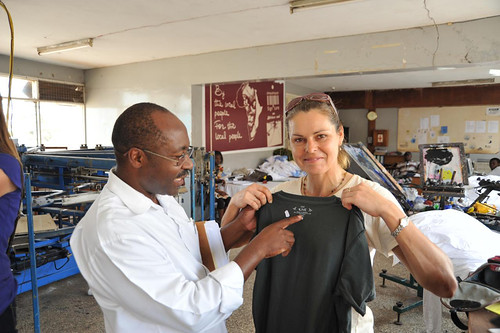Title: Masaka to Kenyan border; diversion to Gulu
Dates: 15th to 19th June GPS:
Distance: 359km Total Distance: 17,806km
Roads: Very busy, especially around Kampala. Hilly between Kampala and Jinja
Weather: Comfortable, warm, cool nights
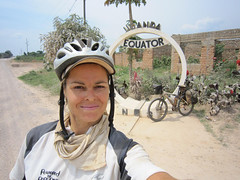 The cycle from Kinoni to Kampala ended up being a marathon day. It started out as a routine ride into Masaka and up the main road which runs parallel to the shores of Lake Victoria (even though the lake was not in view all day). There was about 30km of particularly unpleasant cycling through road works where I was constantly doused with choking dust. The Equator monument was enshrouded too. Nearing Kampala the road was certainly not built for the heavy traffic and I was constantly forced over the broken edges and into the gravel. I had to remain extremely alert and aware of what was coming behind me – usually very fast. I stuck at it and reached the city after 150km, just in time for peak hour traffic. Right as I was tiring, the awareness needed to be most acute. Road works stifled our route plan and by the time we found our way into the city centre I’d clocked 170km – the last hour in the dark. We’d reached Kampala two days ahead of schedule. We had dates to keep; John’s girlfriend MaryJane was due to fly in on the 18th and the following day we needed to drive to Gulu for the next project visit. So to make use of the time I cycled a couple more days to near the Kenyan border.
The cycle from Kinoni to Kampala ended up being a marathon day. It started out as a routine ride into Masaka and up the main road which runs parallel to the shores of Lake Victoria (even though the lake was not in view all day). There was about 30km of particularly unpleasant cycling through road works where I was constantly doused with choking dust. The Equator monument was enshrouded too. Nearing Kampala the road was certainly not built for the heavy traffic and I was constantly forced over the broken edges and into the gravel. I had to remain extremely alert and aware of what was coming behind me – usually very fast. I stuck at it and reached the city after 150km, just in time for peak hour traffic. Right as I was tiring, the awareness needed to be most acute. Road works stifled our route plan and by the time we found our way into the city centre I’d clocked 170km – the last hour in the dark. We’d reached Kampala two days ahead of schedule. We had dates to keep; John’s girlfriend MaryJane was due to fly in on the 18th and the following day we needed to drive to Gulu for the next project visit. So to make use of the time I cycled a couple more days to near the Kenyan border.
 Working my way through shocking traffic out of Kampala along the Jinja Road I was thinking that if the conundrum of minibuses, heavy trucks, motorbikes and cars didn’t kill me, the fumes would. There are no emissions laws here. My eyes were streaming. I passed through some huge tea, sugar cane and rice plantations around the top of Lake Victoria. We camped beside the Nile River, just up from the source of the mighty river where it flows out of Lake Victoria. After Jinja the road opened out making cycling more pleasant.
Working my way through shocking traffic out of Kampala along the Jinja Road I was thinking that if the conundrum of minibuses, heavy trucks, motorbikes and cars didn’t kill me, the fumes would. There are no emissions laws here. My eyes were streaming. I passed through some huge tea, sugar cane and rice plantations around the top of Lake Victoria. We camped beside the Nile River, just up from the source of the mighty river where it flows out of Lake Victoria. After Jinja the road opened out making cycling more pleasant.
We just managed to return to Kampala and Entebbe in time for John to meet MaryJane at the airport. It was great to have MaryJane join us for the two weeks from Kampala to Nairobi.
Throughout the expedition I have been wearing organic cotton t-shirts provided by a sustainable trade company called Edun Live, a sister brand of Edun Apparel. Edun was started by Bono and his wife, Ali Hewson. Garments are made in Sub-Saharan Africa from grower to sewer. The reason for our 370km diversion to Gulu in Northern Uganda was to see where the cotton is produced, meet the farmers and learn how growing organic cotton as a cash crop is transforming many communities.
 It took the best part of a day to reach Gulu. On arrival John Tembo, Project Manager and Agronomist for the Cotton Conservation Initiative of Uganda (CCIU) was waiting to greet us. CCIU was established by Edun and the US-based NGO, Invisible Children (IC). CCIU started under an initiative of IC; profits from Edun Live’s t-shirt sales are funding the project. The aim of CCIU is to contribute to the economic development and resettlement of northern Uganda, in Gulu & Amuru Districts, by providing a financially viable farming alternative to people returning from Internally Displace Peoples Camps to their villages of origin before the insurgency of the Lord’s Resistance Army. John joined us for dinner so we were able to learn about more CCIU and discuss plans for the next day.
It took the best part of a day to reach Gulu. On arrival John Tembo, Project Manager and Agronomist for the Cotton Conservation Initiative of Uganda (CCIU) was waiting to greet us. CCIU was established by Edun and the US-based NGO, Invisible Children (IC). CCIU started under an initiative of IC; profits from Edun Live’s t-shirt sales are funding the project. The aim of CCIU is to contribute to the economic development and resettlement of northern Uganda, in Gulu & Amuru Districts, by providing a financially viable farming alternative to people returning from Internally Displace Peoples Camps to their villages of origin before the insurgency of the Lord’s Resistance Army. John joined us for dinner so we were able to learn about more CCIU and discuss plans for the next day.
Some background as to why this region was selected (other than that it is a good cotton producing area). Since the peace talks that started in June 2006 (after nearly 20 years of war), northern Uganda has enjoyed increasing peace. This has allowed people to return to their original villages and land, and begin to rebuild their lives. However, they are returning to land that has not been tilled for 15 years and more, to places that have no economic activity and opportunities. A large percentage of the returnees are below the age of 20. They have never engaged in agriculture before, having been recipients of food aid and other handouts. They do not have the motivation nor know-how to take their future lives as rural farmers in their own hands, and tend to drift into being unproductive, idling away their days in trading centres. Secondly, since the demise of the cooperative movement and unions under the full privatization and liberalization of the agricultural commodities sector, the smallholder farmer producing cash crops has always been victim of unscrupulous agents and unnecessary middlemen, realizing only a fraction of the true value of his crop. CCIU is cutting out the middlemen and developing a value-added chain so that the garments are produced entirely in Uganda and maximum benefits are returned to the small producers.
Our tour began in the office – CCIU’s nerve centre which also happens to be John’s house. We were introduced to the small number of staff who were still working hard on a Saturday morning. The shelves were stacked with files. Every farmer completes forms detailing the various crops they grow and sprays used in the past. Typically farmers will own up to eight acres on which they will grow their staple foods (maize, cassava, vegetables) and a cash crop – organic cotton. All data is then transferred to soft copy which is presented to the international governing bodies. To be certified as 100% organic there are stringent standards, rules and procedures. The governing bodies regularly check a random selection of producers. CCIU is expanding rapidly. Last year they started with 1000 farmers signing MOUs; this year there are 3500 farmers involved and John says that they will have around 8000 members recruited and committed next year. All farmers receive training; farm leaders are responsible for teaching on average, about 30 of their peers. Each member receives a calendar detailing planting dates and information about farm management, fertility enhancement, pest control and crop rotation. Every group has a committee with a president, secretary and treasurer. CCIU provide training and basic equipment to ensure each group know how to run a committee, meetings and can record what is decided. Group leaders communicate with field officers who in turn answer to two are coordinators who then answer to John and Claude Auberson (Project Director).
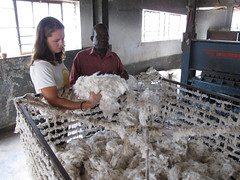 Our first stop was the ginnery in Gulu. Once the cotton is harvested it is sent to the ginnery where the lint is separated from the seed. The factory we saw wasn’t actually organic certified and so is not used by CCUI – it was just to see an example. CCIU are planning very soon to introduce mini-gins which can be operated by the farmers. This is another way they intend to cut out the middleman. Cotton seed itself has a lot of value, normally exploited by the ginnery. Profits from seed products such as oil, soap and animal fodder for example, will soon be received by the growers.
Our first stop was the ginnery in Gulu. Once the cotton is harvested it is sent to the ginnery where the lint is separated from the seed. The factory we saw wasn’t actually organic certified and so is not used by CCUI – it was just to see an example. CCIU are planning very soon to introduce mini-gins which can be operated by the farmers. This is another way they intend to cut out the middleman. Cotton seed itself has a lot of value, normally exploited by the ginnery. Profits from seed products such as oil, soap and animal fodder for example, will soon be received by the growers.
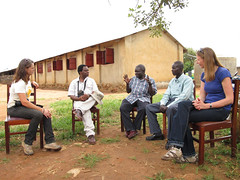 Next we set off along the road, now a rough unsealed road, which if we kept going we’d end up at the Sudanese border. CCIU have set up demonstration plots at secondary schools so that students can learn how to produce organic cotton. The first school we visited, Sacred Heart Girl’s School – which had a reputation as one of the best in the region – was also where the first girls were abducted by the Lord’s Resistance Army. By targeting this school the LRA were intending to maximise their statement of intent, inciting shock and fear in the society. Girls were raped, sold as wives, desensitised and forced to live in the bush as child soldiers.
Next we set off along the road, now a rough unsealed road, which if we kept going we’d end up at the Sudanese border. CCIU have set up demonstration plots at secondary schools so that students can learn how to produce organic cotton. The first school we visited, Sacred Heart Girl’s School – which had a reputation as one of the best in the region – was also where the first girls were abducted by the Lord’s Resistance Army. By targeting this school the LRA were intending to maximise their statement of intent, inciting shock and fear in the society. Girls were raped, sold as wives, desensitised and forced to live in the bush as child soldiers.
 We met the head groundsman, who offers his skills and expertise at a minimal wage, to teach the girls new skills in cotton farming. The seeds had just been planted, so there wasn’t much in the way of cotton crops to see. As we returned through the school he explained that they are in the process of building a substantial wall around the grounds to protect the girls. We visited another school with a demonstration plot – Keyo Secondary School. The head teacher explained that many of the students are badly scarred from the horrors of the war and receive counselling. Two thirds of the students are boys he explained, mostly due to early pregnancies. Life in the IDP camps is not healthy for them – not much to do, living very close to one another, poor levels of education in the generation above. The head teacher and agricultural teacher said that the cotton plot not only empowers the students, the wider community is becoming involved.
We met the head groundsman, who offers his skills and expertise at a minimal wage, to teach the girls new skills in cotton farming. The seeds had just been planted, so there wasn’t much in the way of cotton crops to see. As we returned through the school he explained that they are in the process of building a substantial wall around the grounds to protect the girls. We visited another school with a demonstration plot – Keyo Secondary School. The head teacher explained that many of the students are badly scarred from the horrors of the war and receive counselling. Two thirds of the students are boys he explained, mostly due to early pregnancies. Life in the IDP camps is not healthy for them – not much to do, living very close to one another, poor levels of education in the generation above. The head teacher and agricultural teacher said that the cotton plot not only empowers the students, the wider community is becoming involved.
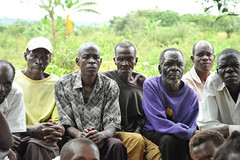 Our final destination on the tour involved a bumpy ride off the main road to meet a group of farmers. We were a little late and they had been waiting patiently for us. The women gave us a warm traditional welcome. I felt honoured by their dancing and singing and thanked them. These people had only returned to their land in the last three years (I think). Prior to this these 50 farmers had existed in the IDP camps, depending on hand outs.
Our final destination on the tour involved a bumpy ride off the main road to meet a group of farmers. We were a little late and they had been waiting patiently for us. The women gave us a warm traditional welcome. I felt honoured by their dancing and singing and thanked them. These people had only returned to their land in the last three years (I think). Prior to this these 50 farmers had existed in the IDP camps, depending on hand outs.
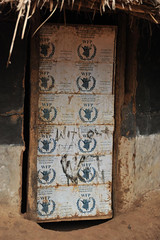 I noticed one of the doors was entirely made of rolled out old food tins from the World Food Program. We sat under a tree and John Tembo led the discussion – interpreted by the area coordinator. When he explained that the t-shirt that I was wearing had been produced from last year’s crop, I could see their eyes light up. I added that my t-shirt was coming home – I think they liked that one too. I doubt they get to see the end product very often.
I noticed one of the doors was entirely made of rolled out old food tins from the World Food Program. We sat under a tree and John Tembo led the discussion – interpreted by the area coordinator. When he explained that the t-shirt that I was wearing had been produced from last year’s crop, I could see their eyes light up. I added that my t-shirt was coming home – I think they liked that one too. I doubt they get to see the end product very often.
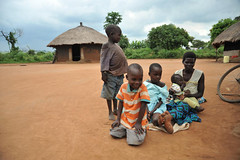 When I asked what they used the money from the cash crop for, most replied that it was to pay for education. There were equal numbers of men and women farmers who all have an equal say in proceedings. The lead farmer in this village was a woman. Overall they seemed a very happy, motivated group. It didn’t take much to make them laugh (as you can see from the photos). Most planned to increase the size of their cotton crops next year.
When I asked what they used the money from the cash crop for, most replied that it was to pay for education. There were equal numbers of men and women farmers who all have an equal say in proceedings. The lead farmer in this village was a woman. Overall they seemed a very happy, motivated group. It didn’t take much to make them laugh (as you can see from the photos). Most planned to increase the size of their cotton crops next year.
The organic cotton as a cash crop really helps these communities become more resilient. Before they would have just produced enough food to eat, perhaps selling any excess at a local market. It was very much a hand to mouth existence. If there was a crop failure, children wouldn’t go to school (if they could afford it in the first place) and/or they would go hungry. Now they are learning how to put money away and plan for the future. Organic cotton attracts 25% above the market value. Once the cotton is set up as the organic cash crop, they also aim to produce other organic crops such as chilli and sesame oil. The whole program aims to become self-sustaining by 2013.
Later that afternoon John organised for us to meet Andrew Morgan and Jessica from Invisible Children as they are obviously the other key stakeholder in this partnership. Invisible Children has been working in northern Uganda for the past six years and has played an integral role in the peace and recovery of the region. IC’s work has been featured on CNN International, Larry King, Oprah and has been the recipient of numerous awards, including the 2008 Ugandan North American Association Service Award, for its work in education and economic development. Most of IC’s fundraising is done by school students in the US. They also provide scholarships for exceptional students in the region who are in vulnerable situations. Jessica took the time to explain in detail exactly what IC do – they really do a fantastic job. www.invisiblechildren.com
We had a very interesting time in Gulu and it was wonderful to see where my t-shirts were made and how the producers were benefitting from CCUI’s work. John and Claude arranged for us to visit the factory in Kampala where the t-shirts are produced.
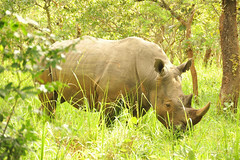 We broke up the long drive back to Kampala with a visit to the Ziwa Rhino Sanctuary. Due to civil unrest in the 70s, rhinos were poached to extinction – the last Rhino was seen in Uganda in 1983. Today rhino horns fetch a high price on world markets where they are sold mostly for Traditional Chinese medicines as well as dagger handles in Yemen. The aim of the Ziwa Sanctuary is to breed white and black rhinos and reintroduce them back into their original habitat, most likely in Murchison Falls National Park. Four white rhinos were transferred from Kenya in 2005. Two more were donated by Disney Animal Kingdom in Florida. The founding three males and three females have produced three calves in the last year.
We broke up the long drive back to Kampala with a visit to the Ziwa Rhino Sanctuary. Due to civil unrest in the 70s, rhinos were poached to extinction – the last Rhino was seen in Uganda in 1983. Today rhino horns fetch a high price on world markets where they are sold mostly for Traditional Chinese medicines as well as dagger handles in Yemen. The aim of the Ziwa Sanctuary is to breed white and black rhinos and reintroduce them back into their original habitat, most likely in Murchison Falls National Park. Four white rhinos were transferred from Kenya in 2005. Two more were donated by Disney Animal Kingdom in Florida. The founding three males and three females have produced three calves in the last year.
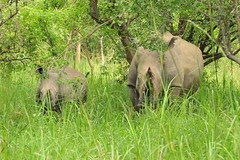 The firstborn named Obama as he has a Kenyan father and an American mother. The sanctuary employs gamekeepers to protect the rhinos around the clock. They also work as guides so visitors like us can track them on foot. It didn’t take long for us to find them. There’s something very special about being just a few metres away from the two tonne animals. By staying in the sanctuary and dining on their high quality meals, our funds were directly supporting the sanctuary.
The firstborn named Obama as he has a Kenyan father and an American mother. The sanctuary employs gamekeepers to protect the rhinos around the clock. They also work as guides so visitors like us can track them on foot. It didn’t take long for us to find them. There’s something very special about being just a few metres away from the two tonne animals. By staying in the sanctuary and dining on their high quality meals, our funds were directly supporting the sanctuary.
 Back in Kampala we drove straight to Phenix Logistics, the factory with produces organic cotton garments for Edun as well as a number of other companies. Innocent, the Phenix project manager showed us around. They receive cotton bales branded with information which tells them exactly who produced to cotton and when and where it was ginned. Cotton from CCIU’s farmers is only used for Edun’s t-shirts and the pedigree will prove it. It has to be this way to receive the 100% organic cotton label. Innocent took us right through the process, from where the cotton has to be manually relaxed from the compressed bales to the final garments. It was fascinating to see the precise ‘clever’ machinery working. There are many processes involved in making the yarn right through to knitting the material, dying, sewing and screen printing. Phenix provides work for 300 employees. They have just received their fair trade certification that ensures they have their staff’s welfare at heart.
Back in Kampala we drove straight to Phenix Logistics, the factory with produces organic cotton garments for Edun as well as a number of other companies. Innocent, the Phenix project manager showed us around. They receive cotton bales branded with information which tells them exactly who produced to cotton and when and where it was ginned. Cotton from CCIU’s farmers is only used for Edun’s t-shirts and the pedigree will prove it. It has to be this way to receive the 100% organic cotton label. Innocent took us right through the process, from where the cotton has to be manually relaxed from the compressed bales to the final garments. It was fascinating to see the precise ‘clever’ machinery working. There are many processes involved in making the yarn right through to knitting the material, dying, sewing and screen printing. Phenix provides work for 300 employees. They have just received their fair trade certification that ensures they have their staff’s welfare at heart.
Having witnessed the whole grower to sewer process I can see that the Gulu farmers are really reaping the benefits. Passionate people are using their expertise to ensure that maximum value is received for their work. Communities are becoming more resilient and better educated.
